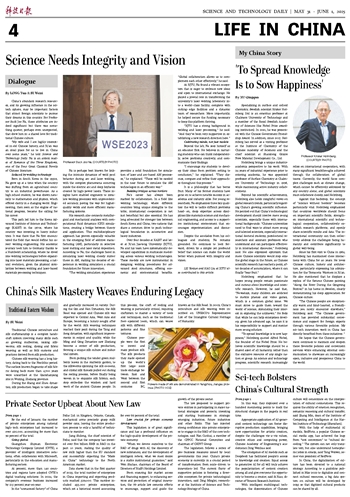
With new technologies such as AI, virtual reality and digital-twin thriving today, the boundaries of the creation, protection, communication and consumption of culture have expanded. Keeping pace with the technology revolution, China has attained high-quality development of its cultural industry through inheritance and innovation.
In recent years, China has begun promoting the conversion of data, documents and processes from analog to digital form, as well as the transformation of cultural services via digital technologies. But still greater efforts are necessary to promote the integration of science and technology with culture for high-quality development of the cultural sector, officials and experts attending the Forum on Building up China's Cultural Strength in Shenzhen in south China on May 26 said.
The Dunhuang Academy in northwestern China has launched the world's first participatory museum in the space-time dimension, called the "Digital Library Cave." It uses game engines and high-definition scanning technology to vividly reproduce the Mogao Grottoes, a cluster of mountain caves in Dunhuang, Gansu province, famous for their murals and other Buddhist relics.
The multi-language service and immersive display are promoting the global dissemination of Dunhuang culture and cross-civilization dialogue, Dunhuang Academy Director Su Bomin said at a parallel session of the forum.
Modern technology is providing solutions for the protection of architecture cultural relics. Ling Ming, president of China Academy of Cultural Heritage, said drone inspection, 3D laser scanning and non-destructive testing are helping to conduct precise examinations and digital documentation of ancient buildings, ensuring minimum intervention in protection work.
For example, to preserve the Wooden Pagoda in Yingxian, a county in Shanxi province, north China, the oldest wooden multi-storied structure in the world, technicians used technologies such as oblique photography, laser scanning, non-destructive testing, and measurement robots to establish millimeter-level digital archives.
In this way, they deployed over a hundred monitoring points to track the structural changes in the pagoda in real time.
Appropriate application of AI-generated content technology can foster disruptive production capabilities, bringing new opportunities for artistic creation, despite the challenges vis-a-vis values, creative ethics and computing power, Chinese Academy of Engineering's academician Ding Wenhua said.
The emergence of AI models such as DeepSeek has facilitated people's access to knowledge and creation. Equal access to generative AI for all will truly achieve the popularization of content creation among all and give everyone the opportunity to become a creator, said Si Xiao, director of Tencent Research Institute.
With intelligent multilingual technologies, the dissemination of Chinese culture will concentrate on the interpretation of cultural connotations. This requires the ability of emotion recognition, semantic reasoning and cultural transfer, said Zhang Min, dean of the Institute of Computing and Intelligence at the Harbin Institute of Technology (Shenzhen).
With the help of multimodal AI models, RedNote, a popular Chinese social media app, has achieved the leap from "text conversion" to "cultural decoding." The system can not only translate text, but also understand homophonic jokes in emojis, said Tang Weiwei, senior vice president of RedNote.
In China, the digitalization of culture has been elevated to a national strategy. According to a guideline published in May 2022 to digitalize and connect cultural resources, a big data system on culture will be developed by 2035 so that digitized cultural products can be shared by all.







